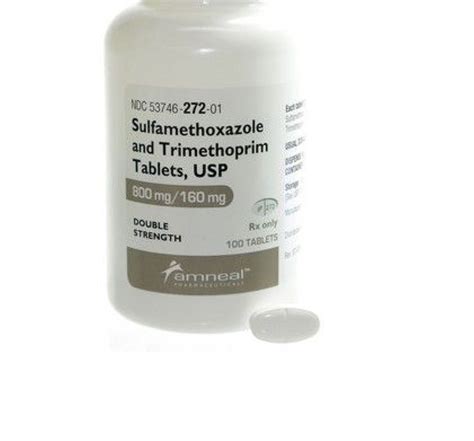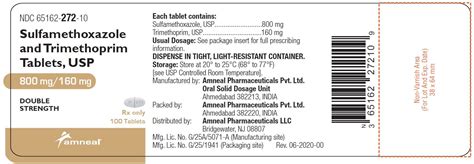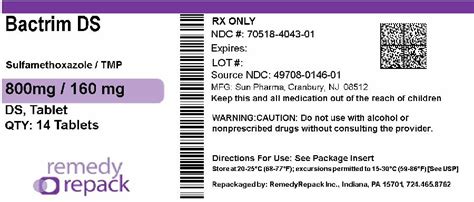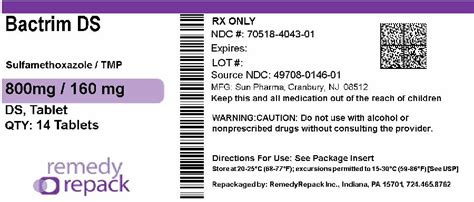Intro
Learn about Sulfamethoxazole Tmp Ds, a widely used antibiotic combination. Discover its uses, side effects, and dosage guidelines for treating urinary tract infections, bronchitis, and other bacterial infections. Understand the benefits and risks of this medication, including interactions and contraindications, to ensure safe and effective treatment.
The rise of antibiotic-resistant bacteria has made it increasingly challenging for medical professionals to effectively treat bacterial infections. Amidst this landscape, sulfamethoxazole/trimethoprim (SMX/TMP), also known as co-trimoxazole, remains a crucial antibiotic combination. SMX/TMP DS, a double-strength formulation of this medication, is widely prescribed for various bacterial infections. In this article, we will delve into the uses, side effects, and dosage guide of sulfamethoxazole TMP DS, providing an in-depth understanding of this essential antibiotic combination.

What is Sulfamethoxazole TMP DS?
Sulfamethoxazole TMP DS is a double-strength formulation of the antibiotic combination sulfamethoxazole and trimethoprim. This medication is a type of sulfonamide, which works by inhibiting the growth of bacteria. SMX/TMP DS is used to treat a variety of bacterial infections, including urinary tract infections (UTIs), respiratory tract infections, and skin infections.
How Does Sulfamethoxazole TMP DS Work?
Sulfamethoxazole TMP DS works by combining two antibiotics, sulfamethoxazole and trimethoprim, which target different stages of bacterial growth. Sulfamethoxazole inhibits the production of folic acid, a nutrient essential for bacterial growth, while trimethoprim blocks the action of dihydrofolate reductase, an enzyme necessary for bacterial DNA synthesis. This dual mechanism of action makes SMX/TMP DS effective against a wide range of bacteria.
Uses of Sulfamethoxazole TMP DS
Sulfamethoxazole TMP DS is used to treat various bacterial infections, including:
- Urinary tract infections (UTIs)
- Respiratory tract infections, such as bronchitis and pneumonia
- Skin infections, such as impetigo and folliculitis
- Ear infections, such as otitis media
- Intestinal infections, such as traveler's diarrhea

Side Effects of Sulfamethoxazole TMP DS
While generally well-tolerated, sulfamethoxazole TMP DS can cause side effects, including:
- Gastrointestinal symptoms, such as nausea, vomiting, and diarrhea
- Allergic reactions, such as rash and itching
- Increased risk of bleeding
- Increased risk of seizures
- Increased risk of hyperkalemia (high potassium levels)
It is essential to note that some individuals may be more susceptible to side effects, including those with kidney or liver disease, and those taking certain medications.
Dosage Guide for Sulfamethoxazole TMP DS
The dosage of sulfamethoxazole TMP DS varies depending on the type and severity of the infection, as well as the patient's age and weight. The typical adult dosage is 800 mg/160 mg (sulfamethoxazole/trimethoprim) every 12 hours for 10 to 14 days. For children, the dosage is adjusted based on weight.

Special Precautions and Contraindications
Sulfamethoxazole TMP DS is contraindicated in patients with:
- Known hypersensitivity to sulfonamides or trimethoprim
- Severe kidney or liver disease
- Blood disorders, such as anemia or agranulocytosis
Special precautions should be taken when administering SMX/TMP DS to:
- Pregnant or breastfeeding women
- Children under 2 months of age
- Patients with kidney or liver disease
- Patients taking certain medications, such as warfarin or phenytoin
Interactions with Other Medications
Sulfamethoxazole TMP DS can interact with various medications, including:
- Warfarin, increasing the risk of bleeding
- Phenytoin, increasing the risk of seizures
- Cyclosporine, increasing the risk of kidney damage
- Digoxin, increasing the risk of digitalis toxicity
It is essential to inform your healthcare provider about all medications, supplements, and herbal products you are taking to avoid potential interactions.

Conclusion
Sulfamethoxazole TMP DS is a widely prescribed antibiotic combination used to treat various bacterial infections. While generally effective, it is essential to be aware of the potential side effects, interactions, and contraindications. By understanding the uses, dosage guide, and special precautions, patients can ensure safe and effective treatment with sulfamethoxazole TMP DS.

We encourage you to share your experiences or ask questions about sulfamethoxazole TMP DS in the comments section below. Your feedback is invaluable in helping us provide accurate and informative content.
What is the typical dosage of sulfamethoxazole TMP DS for adults?
+The typical adult dosage is 800 mg/160 mg (sulfamethoxazole/trimethoprim) every 12 hours for 10 to 14 days.
Can sulfamethoxazole TMP DS be used to treat viral infections?
+No, sulfamethoxazole TMP DS is only effective against bacterial infections and should not be used to treat viral infections.
What are the common side effects of sulfamethoxazole TMP DS?
+Common side effects include gastrointestinal symptoms, allergic reactions, increased risk of bleeding, and increased risk of seizures.
